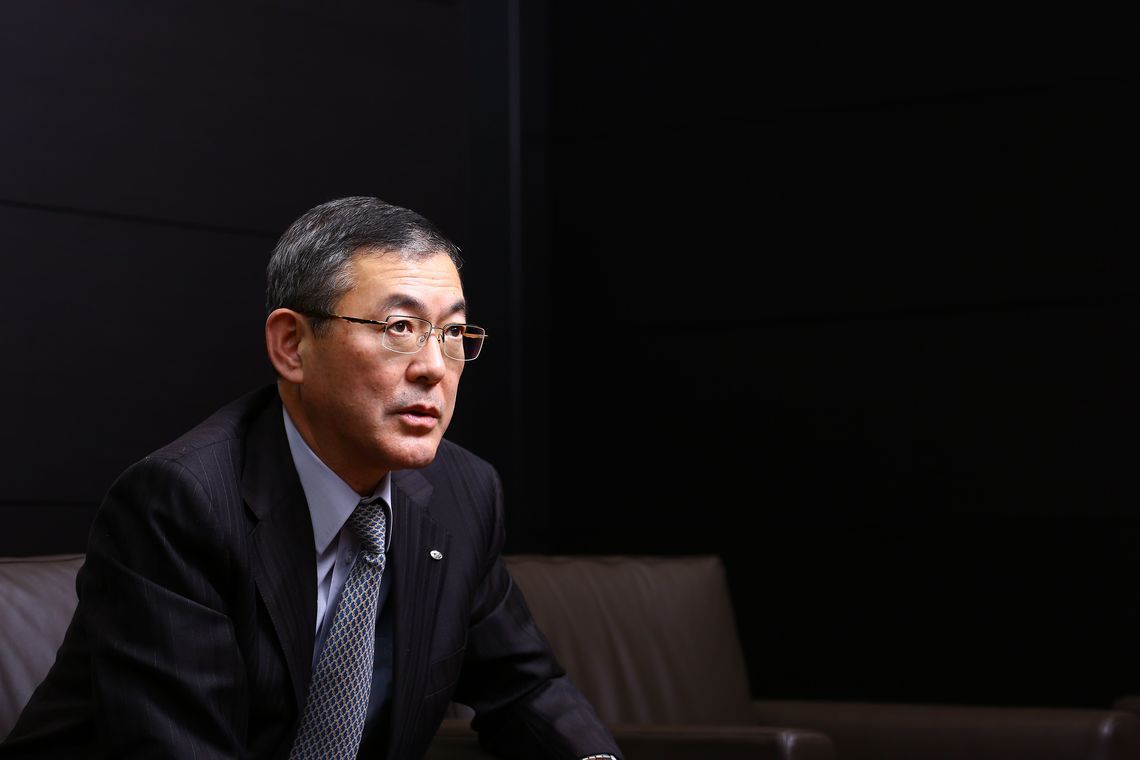
-- What does the growth in the American markets mean to you? Is it a good thing or something to be concerned about?
Of course I’m honored that so many people have bought our Subaru cars. But as a company, the sudden growth in the market also presents some problems. Currently we’re having to revise our entire supply infrastructure to cope with the additional strain on distribution and parts manufacture. However, I always stress to the respective departments that no matter what, safety and quality are our first priority.
To meet the increased demand, there’s always a natural tendency for our manufacturing department to keep the production line moving at all costs. However, we will always cease production and take any necessary steps at the first sight of a fall in quality. As with most companies, we never want to fall behind on our production and we’ll always do our utmost to stay on track. But we pride ourselves on quality and compromising this on our production line will mean compromising the entire company.
One of our strongest points is our roots in the air craft industry (Nakajima Aircraft Company). Now, the company ethos is ‘Enjoyment and Peace of Mind’ which still bears true today. Our safety standards always have been and always will be amongst some of the highest in the industry. It’s from this ethos that we had the idea to make “a car that wouldn’t crash”, which is out of our sales copies.
-- You’ve traditionally always stated that Subaru doesn’t aim to sell more than a million cars. Yet the company’s mid-term projections announced in May 2014 stated that the goal was ‘1.1 million cars + α’ by 2020. What does this mean?
Sales figures have never been our key objective and never will be. However, we had to revise our objectives and projections slightly as we quickly approached 1 million units sold. We could have then just revised the figures to 1.5 million but we felt that would give the impression that Subaru only cares about numbers which is something we wanted to avoid. After much discussion we arrived at 1.1 million and added the ‘+ α’ as some felt that the revised figure would easily be achieved.
These projections largely stem from our increasing sales in North America which accounted for around 600,000 units sold, accounting for more than half of our forecasted total. Many have suggested that with the way things are going, we will probably reach 600,000 within the next year. Of course, these are all projections at best and by no means a definitive number at which we must cease production. That would be a bad business decision.
-- Would you ever consider just ceasing production at 1 million units?
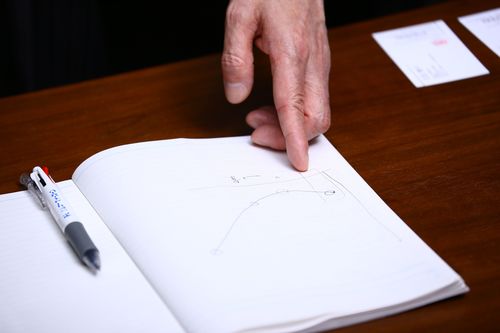
I think that would be unrealistic. We currently have 621 dealers in North America and up until recently those dealers would barely sell 350 cars. Today that figure has grown to 800 cars. Whilst there are some minor differences in local markets between the dealers, their figures show that 1000 cars sold is well within their grasp. It makes no sense for us to then tell these dealers that we won’t make them the cars they need.
As a company, we never make high sales projections but we’re always keeping eye on our supply to meet customers’ demands. For example, if our sales in America exceeds 500,000 one year, we won’t project the same for the following year nor will we reduce that figure. Instead, we always like to add just a little bit more, say 510,000 in this case.
-- Do you think that marginal increases in these numbers will eventually lead to the company straying from its core ethos?
With so many people buying our cars, it’s only natural for us to think of increasing our production and product line up. I used to work in the sales department so I can understand the reasoning behind this. Compact cars would sell well and it would make sense to expand that side of the business to cater for demand. But in doing so, we would lose what makes us unique and in turn what makes us Subaru. That’s why our company motto is to never make a car just to satisfy the numbers.
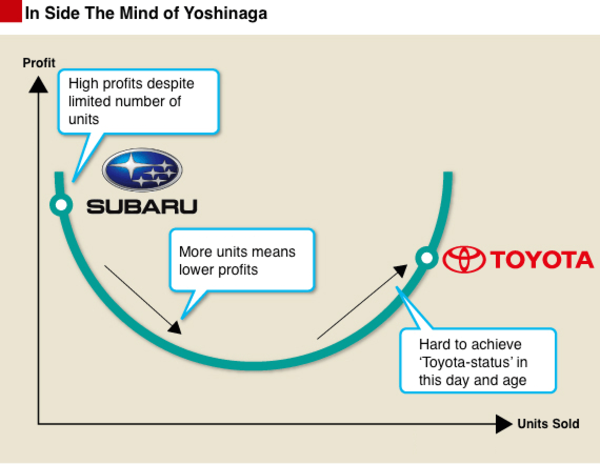
At the moment, we’re doing a lot of niche marketing. The ‘smiling curve’ concept used in business analyses have shown that profits are significantly higher when focusing on a niche market. Conversely, expanding your product range to grow your business actually has the opposite effect and reduces overall profitability. The one exception to this is a company like Toyota who has a broad range of products but have positioned themselves as a dominant position within the industry.
The automotive industry is already well established and matured. It’s near impossible for any company to reach the status that Toyota and GM (General Motors) have. For us to increase our product range to try and attain the same status as these long established giants is simply suicidal.
-- How do you intend on maintaining what makes Subaru so unique?
For better or for worse, companies of a similar size to ours all generally take the same marketing approach – ‘The fun to drive’
Whether its Subaru or Mazda, we’re essentially touting the same thing. Finding a way to differentiate ourselves to make a profit whilst taking the same approach is the difficult part. For us our ‘vision’ was based on our core principles as a company, safety. From this, our ‘Enjoyment and Peace of Mind’ ethos was born.
Since the launch of the first Legacy, the car has become a mainstay not just for clients but for Subaru as well. Whilst a great success, the Legacy moniker also shows that Subaru isn’t one to adapt to change or even desire it for that matter. But is this necessarily a flaw? I don’t think so. We turned what some would call a flaw into our biggest feature – ‘The Legacy is a platform we will continue to improve upon year on year until our dying days.’ – doesn’t sound bad at all.
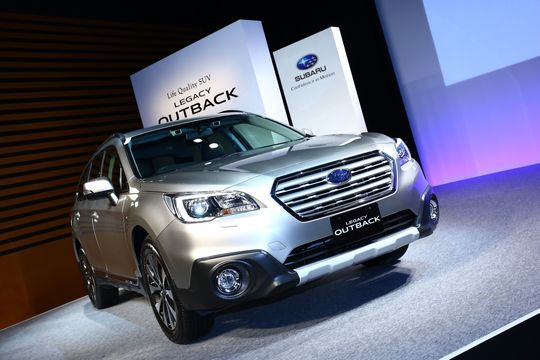
In terms of our overall approach, I would say that it’s comparable to that taken by the late Steve Jobs with Apple’s products; they have a limited range, but each one is the best in its class and outsells the competition. With our Legacy, we market it as the ‘thoroughbred outback’ as it really is the best of the best.
-- Do you feel that developing your niche will turn Subaru into a premium brand like some German marques?
At the moment, there’s a clear divide with cars: either they’re premium or they’re not. But I think there should really be more than just those two. In fashion, there are a lot of different brands with a variety of products ranging from haute couture pieces to sportswear.
Subaru is known in the industry for SUVs and 4WD cars. This is the outward brand that has naturally built up around our vehicles. But I think there’s still plenty of room in the industry for many more ‘brands’ such as sporty or even utilitarian focused line of cars. Of course safety is just as important in any of these scenarios and for us, I believe this is the reason behind our success in America.
-- Which company do you feel is particularly establishing their own ‘brand’?
For overseas markets it would definitely have to be Jeep. It’s really popular particularly over in America. It’s by no means a premium brand but it’s built a reputable following just through the ‘Jeep’ branding alone.
-- Subaru’s Outback SUV and Legacy Sedan launched last year seem to be selling well in America. SUVs in particular are a specialty for Subaru but are the company’s sedans just as well-known there?
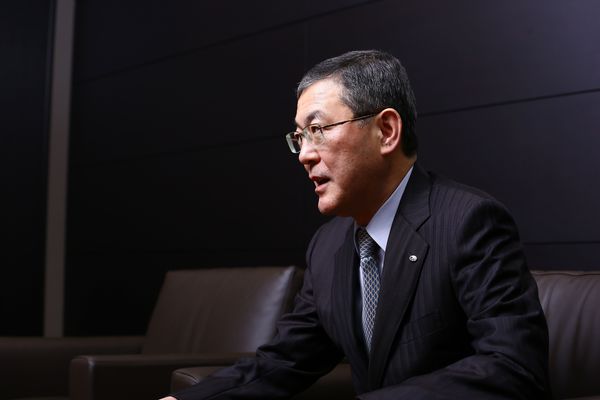
No, not at all. But I am glad the sedans are selling well despite having never told our dealers to actively push these. On the contrary, in Japan there’s a lot of pressure from sales returns to push the sales of sedans which are often seen as the very definition of automobiles.
When I worked in sales, sedans were the hardest models to sell as people buying them tend to have little to no interest in cars. The general mentality of this group of buyers is that they need a car for convenience purposes and want a normal/regular looking model so as not to stand out. The same group of buyers also tend to buy from dealers that are the closest to them as after-service is an important factor. For all these points and criteria, Subaru is at a major disadvantage in America. Our dealers are often fewer and further between than competitors. But making a car that people go that little further to buy is where we see an opportunity.
-- Does that mean Subaru’s buyers continue to grow despite these unfavorable conditions?
It’s hard to definitively say whether customers will be willing to go further to specifically buy one of our sedans. For sure that would be nice. But what’s certain is that our brand has grown enough for customers to want to travel further to buy one of our vehicles.
Having said that, the sales of our Legacy Sedan are around double that of what they were in 2013. Again, the main bottle neck here is our manufacturing facilities in America. It’s clear that the Sedan market is a large one (much larger than that of SUVs) with other car manufactures turning out tens of thousands of sedans each month. Unlike the SUV market, a sudden growth in demand for sedans would put a significant strain on our current infrastructure and we just wouldn’t be able to keep up with the demand.
-- So then the problem boils down to just production?
Coinciding with the launch of the new Legacy and Outback in 2014, we increased our factory output in America from 170,000 cars a year to 200,000. This makes our average monthly factory output around 16,000 cars in line with our sales initial projection for the market over there.
In terms of actual sales figures, 6,700 Legacy’s and 12,500 Outbacks were sold (October 2014 figures) far exceeding our production capacity.
As we don’t manufacture USDM (US domestic market) models in Japan, we really are at our production limit at this moment in time. We often hear customers ask our dealers why we don’t make more. But our projections were accurate projections when first conceived 2 to 3 years ago. On the contrary, over production would have presented a far bigger problem.
-- Will you be opening a larger factory soon?
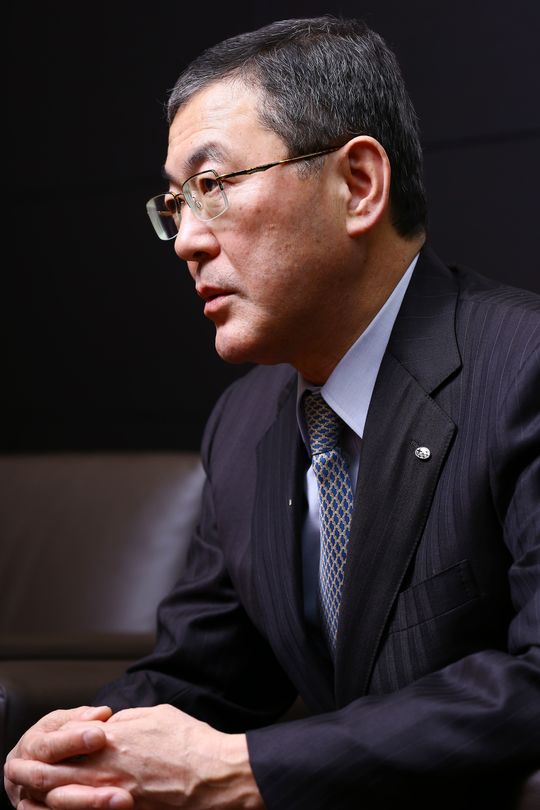
Our immediate plans are to increase the output of our American facilities by 110,000 before the end of 2016. This can be a somewhat dangerous move as our facilities there only manufacture Legacy’s and Outbacks. To offset some of this risk, we’ll be adding the Impreza to the production lineup. We’ll still need to keep a close eye on things though as each model has a lifecycle which means it’s highly unlikely that one model will continue to sell well over many years.
Since this plan ties in closely with the development of the new Impreza, we can’t put it into action any earlier unfortunately. Our factories are always coming up with ways to increase production but having already done so several times over, it’s becoming increasingly harder.
-- Pressure from dealers won’t bring down an entire company down but what about surplus and overstock?
Production or factory output is always an important factor and must be considered carefully. Once changes have been made to a factory, it’s very difficult to reverse it. One wrong decision could result in the factory having to lay people off; a scenario we want to avoid.
I think that part of the reason behind our success in America is down to the supply (of Subaru cars) remaining below demand. No matter how good the marketing, an over supply or surplus would result in our dealers having to offer discounts to sell the cars. Broadly speaking, our discount rate in these scenarios currently stands at around 1000 USD, far below the industry average of 2000+ USD. Whilst we can understand our dealer’s frustration regarding the lack of stock we always have to think about both sides of the argument.
-- Subaru factories in America are currently under contract with Toyota to produce their popular sedan Camrys. What will happen to your partnership with Toyota once that agreement reaches its end in 2016?
Our relationship with Toyota is still an important one for us. Whilst it started out as a manufacturing agreement, we’ve slowly transitioned into collaborating on products and sharing skills. I think this is the right the direction to go in and Toyota’s President, Akio Toyota, also agrees.
Toyota has a large network of factories under its wings that they could easily enlist to manufacture their cars. There isn’t anything special about our factories that drew Toyotas attention as such. But when you think of our specialty, that’s a whole different story all together. For example, take the GT86/BRZ that we built in partnership with them. Toyota has many fantastic products and technological know-how, but what they lack is the ability to produce a boxer engine sports car. That’s where we came in to fill the gap.
For us, we’re still a relatively small company amongst the major car manufacturers. Trying to create a ‘world’s first’-anything is extremely costly and far beyond our reach. But thanks to Toyota we were able to develop and launch our own hybrid vehicle, the XV Hybrid. At a time when environmental issues are under the spotlight more than ever, car manufacturers need to explore hybrid technology in order to survive. Without help from Toyota, who know how long we would have lasted. We currently have a new hybrid in in the works that were also developing with the help of Toyota but this time with a plug in charger.
-- In this competitive industry, do you feel that Subaru can survive? Is it not inevitable for Subaru to one day become a subsidiary of Toyota?
Toyota’s current interest in Fuji Heavy Industries (parent of Subaru) stands at 16.5%. And that’s a figure we’re both happy in maintaining. If we were completely absorbed by another company, Subaru just wouldn’t be Subaru anymore. In other words, our company has the following it does because were not a part of a larger company.
Sales and marketing would also become extremely difficult too. There’s a huge difference between work experiences marketing to be a market leader and marketing to be a nicher.
Our dedication to doing things differently to stay ahead of the competition (being a nicher) shows in our cars. As a result, we’ve built a significant following of customers who share our vision. Compromising on our core principles would mean losing not only our customers but also the very foundation on which our partnership with Toyota is built upon.

